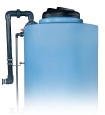Get ready to kick off 2018 safely! Every polyethylene chemical storage tank, regardless of its age, should be inspected at least once a year. Conducting a careful and thorough visual inspection assures the safety of employees, protects the integrity of the chemicals stored, and helps extend the life of the tank.
Topics:
Value Added
Planning to install a new Poly Processing chemical tank or do any work on an installed tank? Don’t do anything until you have the most current Operation and Maintenance Manual. We have overhauled our O&M Manual page with some significant changes that may affect you—whether you have a brand-new tank or a 20-year-old tank.
Our polyethylene chemical storage tanks can safely store many types of chemicals, but different chemicals call for different solutions. Never purchase a chemical tank system without first ensuring that the tank is built to store the chemical you’re using.
If you’re installing a sidewall fitting on a chemical storage tank, you’re actually creating new opportunities for leaks and chemical attack. Every hole drilled into a tank’s wall can become a weak point in your tank. You can prevent a breach in your tank’s system by carefully selecting your fittings.
Topics:
Fittings and Accessories
Some chemical storage tank applications require a fixed ladder to get above the tank for inspections, check gauges, and maintain level sensors or mixers. These fixed ladders connect to a walkthrough, or landing platform, allowing you to do your work. Poly Processing does not allow walking on the dome of the tank at any time due to it being plastic as well as a slippery and unstable surface.
Can you name one of the most common things companies forget to consider when purchasing a tank? Surprisingly, many operations do not consider how they will fully discharge their tanks in advance of purchasing it. It’s not until afterward that they realize the need to find a solution. However, this decision should be made in advance because it is a critical part of tank maintenance and chemical purity process.
Topics:
Chemicals
Regardless of the chemical that you are storing, nearly every chemical releases fumes. Yet, some chemicals, like hydrochloric acid, acetic acid and hydrofluoric acid, produce fumes that can’t be released into the atmosphere. These fumes are very aggressive. They can harm your chemical storage tank, your equipment, and your employees.
Topics:
Chemicals
Secondary containment is an important safeguard that helps plant operators mitigate the risks associated with chemical spills and avoid damage to equipment and property. In this system, a secondary container or wall encompasses the primary container. Should the primary container fail and cause a chemical leak, the secondary container prevents the chemical from spilling outside the system.
Did you know that every chemical storage tank has a stock number and a serial number? One will help you order your tank, and one will help you identify the tank you’ve purchased. It can be easy to get confused about which number you need to know, what it tells you, and when you need it. But at Poly Processing, we want you to be well-educated and fully informed about our products, and your individual tanks. So here’s a quick breakdown on storage tank serial numbers and stock numbers.



